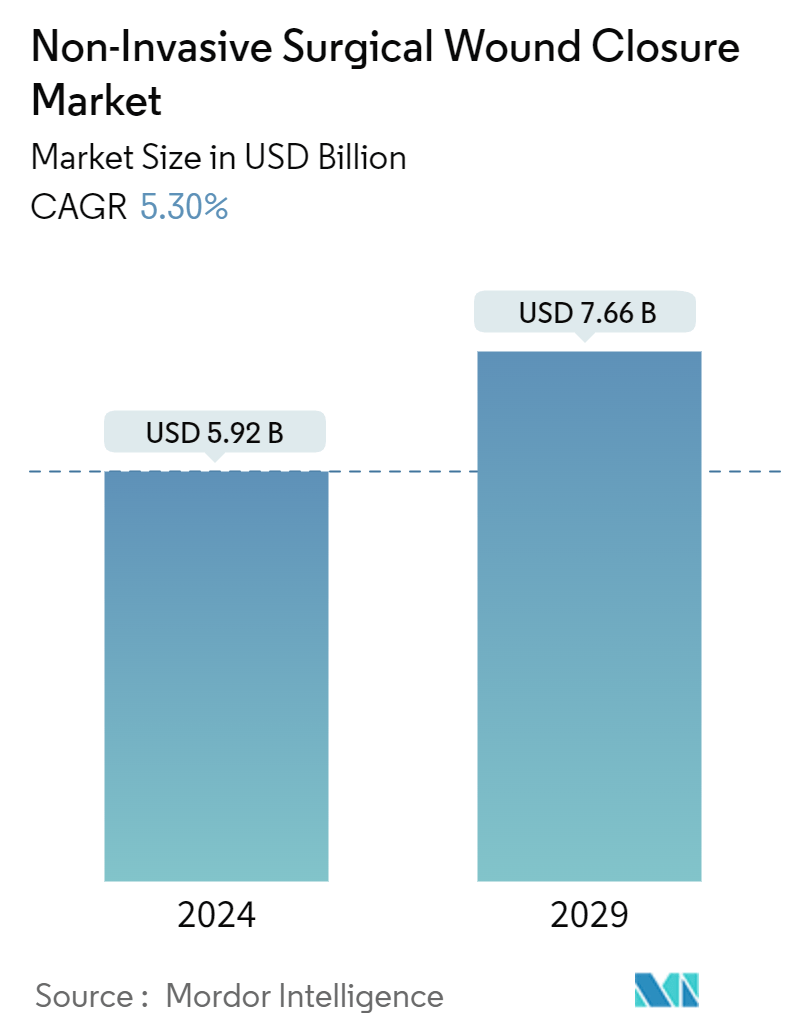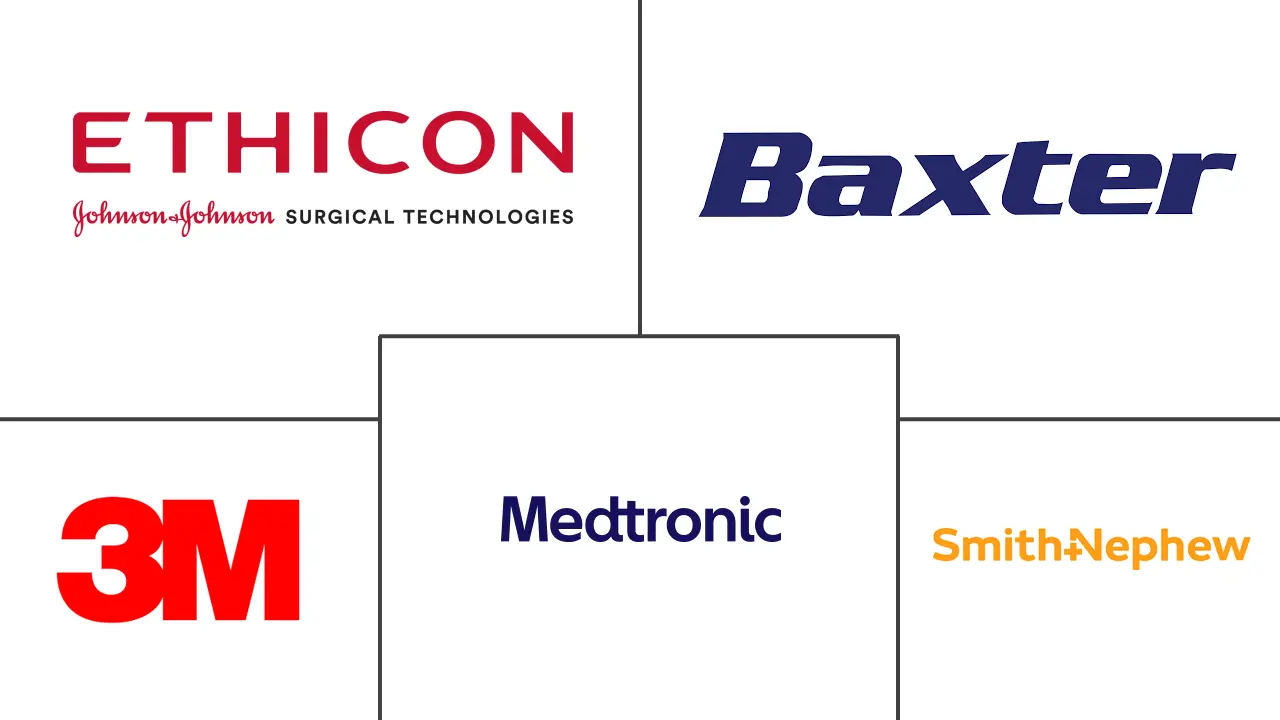Market Size of Non-Invasive Surgical Wound Closure Industry

| Study Period | 2019 - 2029 |
| Market Size (2024) | USD 5.92 Billion |
| Market Size (2029) | USD 7.66 Billion |
| CAGR (2024 - 2029) | 5.30 % |
| Fastest Growing Market | Asia Pacific |
| Largest Market | North America |
Major Players
*Disclaimer: Major Players sorted in no particular order |
Non-Invasive Surgical Wound Closure Market Analysis
The Non-Invasive Surgical Wound Closure Market size is estimated at USD 5.92 billion in 2024, and is expected to reach USD 7.66 billion by 2029, growing at a CAGR of 5.30% during the forecast period (2024-2029).
Several key factors drive the non-invasive surgical wound closure market. Among the main drivers are the rising demand for minimally invasive surgical procedures, the rising popularity of scar-free aesthetic results, improvements in wound closure technology, and the rising number of chronic illnesses and trauma cases requiring surgical interventions. These drivers are expected to fuel the market’s growth during the forecast period.
The rise in the number of trauma cases leads to a higher demand for wound closure products, including non-invasive options. This growing prevalence can be considered as one of the crucial drivers for the growth of this market. For instance, according to one of the reports released by the World Health Organization (WHO) in December 2023, 20 to 50 million individuals experienced non-fatal injuries, often resulting in disabilities in 2022. This significant number reflects the increased demand for surgical procedures as well. Trauma cases often result in various types of wounds, ranging from minor to severe, and the choice of wound closure method can depend on the nature and extent of the injury. Therefore, these factors are expected to boost the growth of this market.
Apart from this, the surge in aesthetic procedures is expected to propel the demand for non-invasive wound closure products, thereby boosting market growth during the forecast period. For instance, according to the International Society of Aesthetic Plastic Surgery (ISAPS) statistics published in June 2024, liposuction remained the most common surgical procedure, with over 2.2 million operations. Further, the cosmetic industry experienced a significant rise in facial and head procedures, totaling over 6.5 million, reflecting a 19.6% increase in 2023.
As per the same source, the most popular treatments included eyelid surgeries, exceeding 1.7 million, rhinoplasties at 1.1 million, and lip enhancements/perioral procedures at 0.9 million. Additionally, there were 4.1 million breast procedures and 5.1 million body and extremity treatments performed in 2023. Patients increasingly seek procedures that result in minimal scarring, particularly in visible or cosmetically sensitive areas like the face, neck, and hands. This demand drives healthcare professionals to explore non-invasive wound closure options that can achieve better cosmetic results compared to traditional sutures or staples. Also, the shift toward minimally invasive surgical procedures is propelling the growth of this market.
Additionally, advancements in technology have significantly impacted the non-invasive surgical wound closure market, leading to improved patient outcomes, reduced recovery times, and enhanced overall healthcare practices. The development of advanced adhesive materials, such as biocompatible and bioabsorbable glues, tapes, and sealants, has revolutionized wound closure techniques. For instance, Futura Surgicare Pvt Ltd, which operates through Dolphin Sutures, launched a Hemostatic product under the brand Hemostax (oxidized regenerated cellulose), categorized in a new vertical Dolphin Hemostats in February 2022. It is a topical adhesive used for the closure of surgical wounds. Therefore, advancements in technology for non-invasive surgical wound closure are anticipated to fuel the growth of the market during the forecast period.
Therefore, owing to factors such as the rise in the number of trauma cases, advancements in technology, and a surge in aesthetic procedures, this market is anticipated to witness growth in the coming years. However, factors like stringent regulatory guidelines and the high cost associated with advanced non-invasive surgical wound closure products limit the growth of the market.
Non-Invasive Surgical Wound Closure Industry Segmentation
As per the scope of the report, non-invasive surgical wound closure products are used to close surgical wounds using a non-invasive approach. This often reduces the risk of surgical site infection and increases the satisfaction level of the patients and surgeons. The non-invasive surgical wound closure market is segmented by product, application, end-user, and geography. By product, the market is segmented into adhesives, tissue sealants and hemostats, zip products, and other innovative products. These other innovative products include zip skin closure products and others. By application, the market is segmented into general surgery, cosmetic procedures, orthopedics, cardiology, obstetrics, gynecology, and other applications. Other applications include neurosurgery, ophthalmic surgery, and urological surgery. By end user, the market is segmented into hospitals and specialty clinics, emergency service centers, ambulatory surgical centers, and other end users. Other end users include nursing homes, rehabilitation centers, and research institutes. By geography, the market is segmented into North America, Europe, Asia-Pacific, the Middle East and Africa, and South America. For each segment, the market sizing and forecasts were made on the basis of value (USD).
Non-Invasive Surgical Wound Closure Market Size Summary
The non-invasive surgical wound closure market is poised for significant growth, driven by the increasing demand for minimally invasive procedures and advancements in wound closure technologies. The market is experiencing a surge in interest due to the rising prevalence of chronic illnesses and trauma cases, which necessitate surgical interventions. The growing popularity of scar-free aesthetic results is also contributing to the market's expansion, as patients increasingly seek procedures that minimize visible scarring. Technological advancements, such as the development of biocompatible and bioabsorbable adhesives, are revolutionizing wound closure techniques, offering improved patient outcomes and reduced recovery times. These factors collectively are expected to propel the market forward during the forecast period.
The market is characterized by a strong preference for adhesive-based wound closure methods, which offer less invasive and virtually painless alternatives to traditional sutures and staples. The use of tissue adhesives is on the rise, driven by their advantages, including reduced procedure time, minimal tissue trauma, and enhanced cosmetic outcomes. The North American region is anticipated to witness substantial growth, fueled by the increasing number of surgical procedures and a growing elderly population. The region's market expansion is further supported by a rise in product approvals, such as those from the US FDA, which encourage the adoption of non-invasive wound closure methods. The market remains highly fragmented, with key players like Johnson and Johnson (Ethicon), 3M, Smith+Nephew, and Medtronic actively engaging in strategic initiatives to enhance their product offerings and capture a larger market share.
Non-Invasive Surgical Wound Closure Market Size - Table of Contents
-
1. MARKET DYNAMICS
-
1.1 Market Overview
-
1.2 Market Drivers
-
1.2.1 Rising Number of Surgical Procedures and Growing Prevalence of Trauma Cases
-
1.2.2 Technological Advancements In Regards to the Advanced Products
-
-
1.3 Market Restraints
-
1.3.1 High Cost Associated with Advanced Non-invasive Surgical Wound Closure Products
-
1.3.2 Stringent Regulatory Guidelines
-
-
1.4 Porter's Five Forces Analysis
-
1.4.1 Threat of New Entrants
-
1.4.2 Bargaining Power of Buyers/Consumers
-
1.4.3 Bargaining Power of Suppliers
-
1.4.4 Threat of Substitute Products
-
1.4.5 Intensity of Competitive Rivalry
-
-
-
2. MARKET SEGMENTATION (Market Size by Value - USD million)
-
2.1 By Product
-
2.1.1 Adhesives
-
2.1.2 Tissue Sealants and Hemostats
-
2.1.3 Zip Products
-
2.1.4 Other Products
-
-
2.2 By Application
-
2.2.1 General Surgery
-
2.2.2 Cosmetic Procedures
-
2.2.3 Orthopedic
-
2.2.4 Cardiology
-
2.2.5 Obstetrics and Gynaecology
-
2.2.6 Other Applications
-
-
2.3 By End User
-
2.3.1 Hospitals and Specialty Clinics
-
2.3.2 Ambulatory Surgical Centers
-
2.3.3 Other End Users
-
-
2.4 By Geography
-
2.4.1 North America
-
2.4.1.1 United States
-
2.4.1.2 Canada
-
2.4.1.3 Mexico
-
-
2.4.2 Europe
-
2.4.2.1 Germany
-
2.4.2.2 United Kingdom
-
2.4.2.3 France
-
2.4.2.4 Italy
-
2.4.2.5 Spain
-
2.4.2.6 Rest of Europe
-
-
2.4.3 Asia-Pacific
-
2.4.3.1 China
-
2.4.3.2 Japan
-
2.4.3.3 India
-
2.4.3.4 Australia
-
2.4.3.5 South Korea
-
2.4.3.6 Rest of Asia-Pacific
-
-
2.4.4 Middle East and Africa
-
2.4.4.1 GCC
-
2.4.4.2 South Africa
-
2.4.4.3 Rest of Middle East and Africa
-
-
2.4.5 South America
-
2.4.5.1 Brazil
-
2.4.5.2 Argentina
-
2.4.5.3 Rest of South America
-
-
-
Non-Invasive Surgical Wound Closure Market Size FAQs
How big is the Non-Invasive Surgical Wound Closure Market?
The Non-Invasive Surgical Wound Closure Market size is expected to reach USD 5.92 billion in 2024 and grow at a CAGR of 5.30% to reach USD 7.66 billion by 2029.
What is the current Non-Invasive Surgical Wound Closure Market size?
In 2024, the Non-Invasive Surgical Wound Closure Market size is expected to reach USD 5.92 billion.

